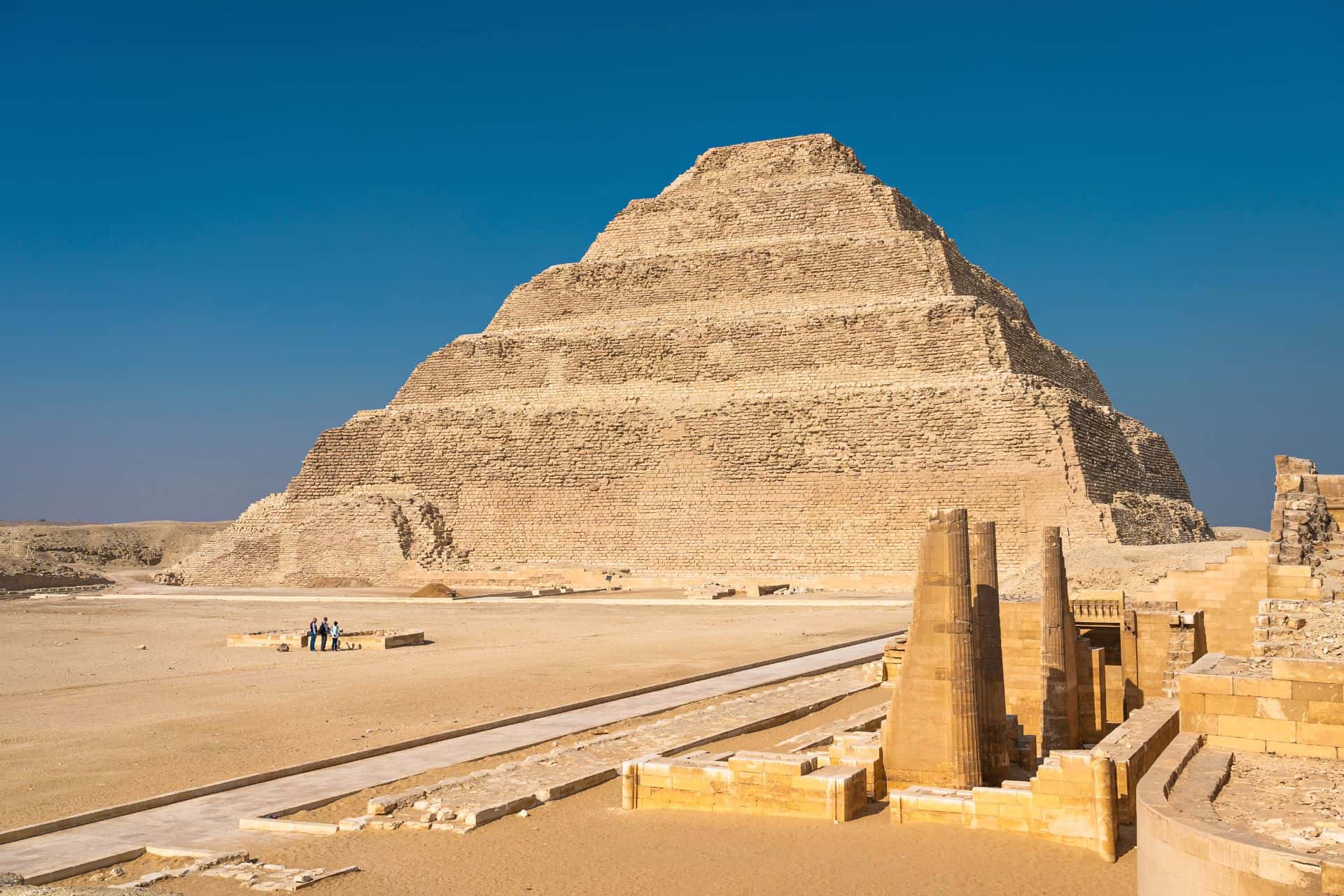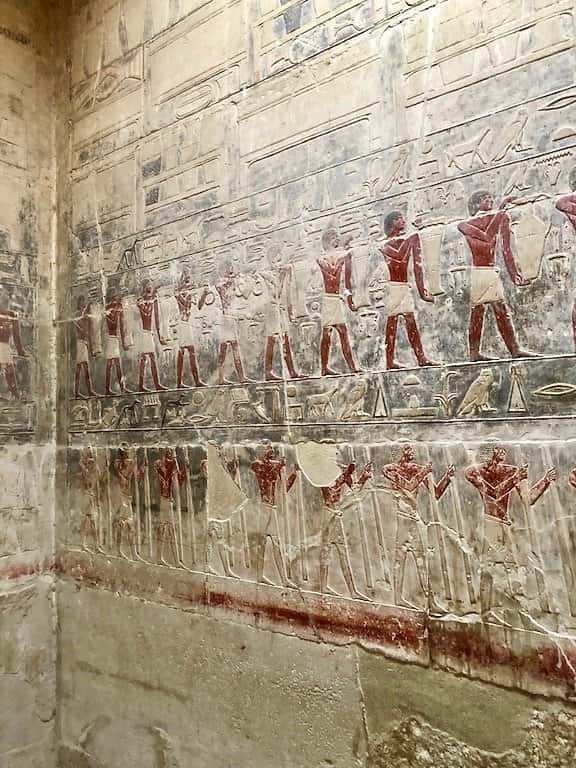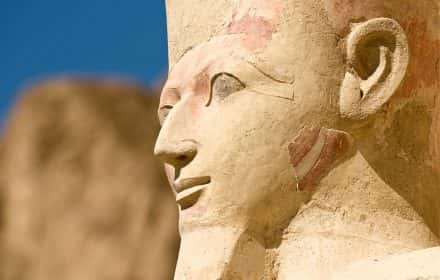This site uses affiliate links, meaning that if you make a purchase through our links, we may earn an affiliate commission.
Nestled in the arid landscapes of Egypt, Saqqara stands as a timeless testament to the ingenuity and architectural prowess of ancient civilizations. This archaeological gem, often overshadowed by its famous neighbor, the Giza Plateau, holds its own mystique and historical significance.
Saqqara, home to the iconic Step Pyramid of Djoser, is a captivating journey through the annals of Egyptian history, offering a glimpse into a world that thrived thousands of years ago.
In this guide, we invite you to embark on a virtual journey with us as we explore how to visit and what to see in Saqqara, Egypt. Whether you’re an avid history buff, an intrepid traveler, or simply curious about the wonders of antiquity, Saqqara promises an unforgettable adventure.
From the towering pyramid that has weathered the sands of time to the intricate details of ancient tombs, our guide will unveil the secrets and treasures that await you in this awe-inspiring archaeological wonderland.
So, pack your virtual bags, and let’s uncover the mysteries of Saqqara together.
Discovering Saqqara: Location and Travel Tips
Saqqara, spanning an expansive area of approximately 7 by 1.5 kilometers (4.35 by 0.93 miles), holds a prestigious place in history as the birthplace of pyramid construction in Egypt.
Located on the western bank of the majestic River Nile, Saqqara rests about 30 kilometers (19 miles) to the south of Cairo. The journey from the bustling Egyptian capital to Saqqara is relatively swift, typically taking around one hour by car.
What makes this excursion all the more enticing is the opportunity to combine a visit to Saqqara with a trip to the ancient city of Memphis.
Memphis, once the illustrious capital of Egypt, boasts its own trove of historical treasures. To delve deeper into this historical journey, be sure to explore our guide on How to Visit and What to See in Memphis, Egypt. With these two remarkable destinations in close proximity, your Egyptian adventure promises to be a truly enriching experience.
Image Credit: Map data ©2020 ORION-ME
I think that having a private driver and a guide is the best way to reach and tour Saqqara. This option gives you total flexibility. Also, having a knowledgeable guide by your side is simply invaluable.
Now, if you are staying in one of the hotels in Cairo, your hotel will probably be more than happy to arrange for you a driver and a guide. Needless to say, this is an expensive option, but it is all worth it.
You can ask your hotel for a bus tour that stops at all major attractions in and around Cairo or for a day trip tour from Cairo that covers several stops. It is probably one of the least expensive options. But, it does not give you much flexibility.
Another option is to just book a taxi and head to Saqqara. You will always be able to hire a guide right at the entrance to the Saqqara Archaeological Site.
What to See When Visiting Saqqara
Saqqara is a treasure trove of archaeological wonders, featuring an array of pyramids that have fascinated historians and explorers for centuries. Among these, the iconic Step Pyramid of Djoser reigns supreme, its ancient grandeur making it one of the most renowned structures in the world.
But Saqqara offers more than just pyramids; it boasts a collection of mastabas, the distinctive flat-roofed tombs that reveal the burial practices of the ancient Egyptians. These mastabas provide an intriguing glimpse into the customs and beliefs of this ancient civilization.
For those eager to delve deeper into Saqqara’s rich history, the Imhotep Museum awaits. The entrance ticket to Saqqara Archaeological Site not only grants access to this museum but also makes it an ideal starting point for your Saqqara exploration.
Inside the Imhotep Museum, you can immerse yourself in the fascinating world of Saqqara’s excavations and discoveries. It’s an opportunity to journey through time, as you uncover the secrets and stories hidden within the ancient sands.
So, begin your Saqqara Archaeological Site tour at the Museum of Imhotep, where history comes to life, and let the wonders of this ancient site unfold before your eyes.
The Imhotep Museum
The Imhotep Museum pays homage to the legendary Egyptian architect Imhotep, whose brilliance is credited with the design of the world-famous Step Pyramid of Djoser and the entire complex surrounding it.
This institution serves as a captivating portal into the architectural genius of Imhotep and the remarkable archaeological heritage of Saqqara.
Comprising several halls adorned with meticulously curated and informative exhibits, the museum offers a captivating journey through the annals of history.
Within its walls, you can marvel at a wealth of archaeological discoveries stemming from various excavations conducted in Saqqara. Among the most intriguing artifacts are the ancient tools once wielded by skilled craftsmen in the construction of monumental structures.
Additionally, the museum houses a remarkable collection of green and blue faience wall tiles, which once adorned the chambers beneath the pyramid complex, showcasing the exquisite craftsmanship of ancient Egypt.
For those planning their visit, the Imhotep Museum operates from 8 a.m. to 5 p.m. during the summer months (May through August) and from 8 a.m. to 4 p.m. throughout the winter months (September through April).
What is even more enticing is that the cost of admission to this museum is seamlessly included in the entrance ticket to the Saqqara Archaeological Site, making it a must-see destination for anyone eager to unravel the mysteries of this historical treasure trove.
The Step Pyramid of Djoser
The crowning jewel of Saqqara, the Step Pyramid of Djoser, stands as a testament to the remarkable architectural genius of Imhotep, who is celebrated as its visionary creator.
This awe-inspiring pyramid not only holds the distinction of being Egypt’s inaugural pyramid but also boasts the remarkable distinction of being the oldest surviving stone building globally, a historical marvel that continues to captivate visitors to this day.
This monumental feat of construction unfolded over a span of time from 2630 to 2611 BC, a period that saw the birth of one of the world’s most iconic architectural achievements.
The Step Pyramid soars to an impressive height of 60 meters (204 feet), dominating the Saqqara landscape with its six distinct steps.
Each step, a testament to the ancient Egyptians’ architectural prowess, represents a remarkable chapter in the history of human engineering and ambition.
Standing in the shadow of the Step Pyramid, one can’t help but marvel at the enduring legacy of Imhotep and the generations of craftsmen and laborers who transformed his visionary design into a tangible reality.
This ancient wonder serves as a bridge to the distant past, inviting all who visit to witness the genius of Imhotep and the grandeur of Egypt’s historical heritage.
The Step Pyramid Funerary Complex
The Step Pyramid of Djoser, nestled in the heart of Saqqara, was not merely a standalone structure but a central element of a grand funerary complex that once thrived in this historic site.
This complex was a sprawling architectural marvel that encompassed temples, courtyards, shrines, and living quarters designed to serve the needs of the priests responsible for the pyramid’s upkeep and religious rituals.
Adding to its enigmatic allure, the entire complex was meticulously enclosed by a protective wall. This defensive perimeter was adorned with a remarkable feature: 13 false doors, cunningly cut into the wall.
These false doors, as my guide shared, served a dual purpose, both mystical and practical. They were believed to facilitate the passage of the deceased into the afterlife while also serving as a deterrent to would-be intruders.
Further fortifying the complex’s defenses, a trench surrounded the imposing wall, offering an additional layer of security. These measures combined to safeguard the sacred sanctum and discourage any potential threats.
Today, fortunate visitors to Saqqara can still witness the remarkable preservation of elements of the Step Pyramid Funerary Complex.
A highlight not to be missed is the exquisite Hypostyle Hall at the Temple of Djoser.
The Hypostyle Hall at the Temple of Djoser is a mesmerizing testament to ancient Egyptian architecture and craftsmanship.
Don’t forget to capture the beauty and mystique of this historical treasure with your camera, as each image you capture becomes a window into the distant past.
The Tomb of Ka-gmni
The tomb of Ka-gmni is a complex comprised of eight meticulously adorned chambers along with five functional storage rooms.
In the first chamber, a captivating narrative unfolds through intricate decorations.
These scenes offer a window into the daily lives of the time, showcasing activities such as fishing and fowling.
Moreover, the chamber is adorned with splendid depictions of various birds and animals, meticulously rendered with artistic finesse. It also boasts beautiful reliefs portraying offerings bearers, shedding light on the religious and ceremonial practices of ancient Egypt.
Ka-gmni, a prominent figure from the early reign of King Teti during the Sixth Dynasty of Egypt, held a multitude of esteemed titles and roles.
Notably, he served as an overseer of the two houses of gold and the two treasuries. His religious duties were equally significant, including the prestigious roles of High Priest of Re and Stolist of Min.
Within the royal palace, Ka-gmni’s influence extended to roles such as overseer of the two chambers of the king’s adornment, director of the Mansions of the White and Red Crowns, and keeper of the head ornaments.
As vizier, his responsibilities encompassed overseeing the scribes of the king’s documents, supervising all the works of the king, and presiding as overseer of the six great courts.
Furthermore, an intriguing familial connection adds to the historical tapestry, as Ka-gmni’s wife, Nebtynubkhet Sesheshet, is believed to have been a King’s Daughter, potentially the daughter of Teti himself.
This tomb not only serves as a testament to Ka-gmni’s multifaceted role in ancient Egyptian society but also offers a glimpse into the intricate web of relationships and responsibilities within the royal court.
How to Visit Saqqara - Things to Know Before You Go
- How much time should you allocate for your visit to Saqqara?
To fully savor the wonders of the Saqqara Archaeological Site, it’s recommended to set aside a minimum of 1 to 2 hours for your exploration.
This timeframe allows for a comprehensive tour that encompasses visiting one of the remarkable tombs, exploring the intriguing funerary complex, and capturing memorable snapshots of the iconic Step Pyramid.
Keep in mind that if you plan to explore additional tombs, you should factor in additional time accordingly.
- What’s the cost of admission to Saqqara?
Upon your arrival at the entrance to the Saqqara Archaeological Site, you can purchase your admission ticket, which is priced at 180 Egyptian Pounds (EGP).
This single ticket provides access not only to the Saqqara Archaeological Site itself but also grants entry to the enlightening Imhotep Museum, ensuring you receive the full breadth of this historical experience.
- What are the operating hours of the Saqqara Archaeological Site?
The Saqqara site welcomes visitors throughout the week. During the summer months, from May through August, the site opens its gates at 8 a.m. and extends its visiting hours until 5 p.m., affording ample time for exploration. As the seasons transition into the cooler winter months, spanning from September through April, the site’s operating hours remain accommodating, commencing at 8 a.m. and concluding at 4 p.m.
- When is the ideal time to embark on your Saqqara adventure?
For an optimal experience at Saqqara, it’s highly advisable to plan your visit as early as possible. Arriving by 8 a.m. or earlier holds the key to unlocking the tranquil charm of this historical haven.
At this early hour, you will find yourself in the privileged position of having the site virtually to yourself, providing the perfect opportunity to capture stunning photographs free from the hustle and bustle of fellow tourists.
As the morning progresses and the clock nears 10 am, the site begins to welcome more visitors, marking the start of increased foot traffic.
Additionally, if your Saqqara adventure falls during the sweltering summer months, it is crucial to consider the sun’s relentless intensity. Beginning your journey in the cool of the morning not only ensures more comfortable conditions but also allows you to maximize your time before the heat peaks.
Remember to don a hat for added protection from the sun and stay well-hydrated to make the most of your Saqqara visit.
You Might Also Like:
How to Visit and What to See at KHAN EL-KHALILI BAZAAR in Cairo
Perfect 7-Day Egypt Itinerary for First Visit (Cairo, Aswan, Luxor, Abu Simbel)
What to See at the TEMPLE of HORUS at EDFU (5 Things You Can’t Miss)
What to See at the TEMPLE of KOM OMBO, Egypt (9 Things You Can’t Miss)
How to Visit Abu Simbel: Everything You Need to Know to Plan Your Visit
How to Visit and What to See at the TEMPLE of PHILAE in Aswan
Best Day Trip from Cairo – Dahshur, Memphis, and Saqqara (Maps+Photos)
19 Must-See Things at Egyptian Museum in Cairo (+Practical Tips)
Now, It Is Your Turn, I Would Like to Hear Back from You!
Are you planning on visiting Saqqara?
Please let me know! Drop me a quick comment right below!
Also, click on any of the images below to get inspired and to help you with the planning process for your trip to Egypt!
















